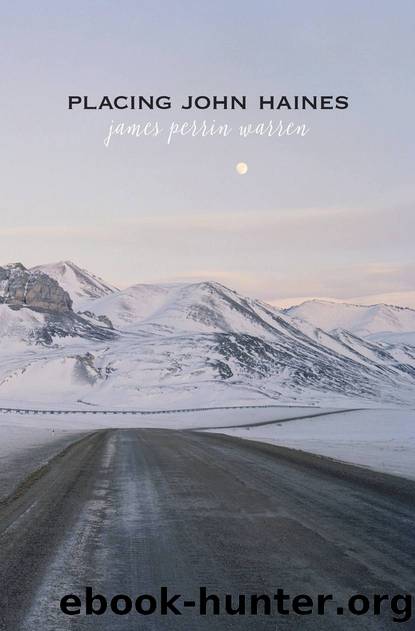Placing John Haines by James Perrin Warren

Author:James Perrin Warren [Warren, James Perrin]
Language: eng
Format: azw3
ISBN: 9781602233102
Publisher: University of Alaska Press
Published: 2017-02-14T16:00:00+00:00
once more the whirlwind sweeps
the dark-tongued leaves
to the lap of a woman so old
she is a child who cannot remember
when her book of the marvelous
came unthreaded
and the pages were scattered.
Instead of a fixed and permanent truth, art creates a perpetual whirlwind of “sensible and living order.” The artist is charged, in the poem, with gathering and ordering the scattered leaves, translating their dark tongues, and then beginning the process over again. But the most authoritative figure remains the sweeping whirlwind, so reminiscent of the wind in “The Stone Harp” and the poems of In a Dusty Light.
The 1987 conversation between Haines and Adams echoes the “Provisional Draft” in a number of topics and terms. Their discussion begins, as it must, with Alaska and the importance of place, but Haines insists on placing those terms in a larger context. For Haines, the homesteading experience can stand as “a late episode in the American romance with the frontier” (JHP Box 18, Folder 8, p. 4). But it is more deeply, and characteristically for Haines, a metaphor for “the human journey.” Haines moves toward the old ways of deep time, just as he moves toward the figure of the ancient hunter in the “Provisional Draft.” Here he notes that “the journey of human life begins right here, on this ground—in that old hunting and gathering existence. It goes from there into tribal life, into town life and civilization, and increasing complexity. And at periodic intervals it returns to something that is fairly simplified, even primitive” (4). For Haines, this recurring process is more than simply an experience of authenticity. The repeated journey allows him to “understand events and particulars, to sort them out so that they make a higher kind of sense—more or less as an historian or an anthropologist will do, in sifting the evidence, and consulting the texts, to find some useful pattern” (5). The larger historical and mythic context is significant for Haines personally, as well, for he admits to Adams that over the past ten to twelve years he has experienced “a real descent into the underworld,” a “black depression and confusion of mind,” and “periods of personal doubt and confusion” (5–6). On the other hand, “periods of clarification” come in the form of a sense of direction, along with a sense of being part of the larger human journey.
In addition to the trope of the journey, Haines dwells at some length on the critical usefulness of what he calls the “European tradition.” He gladly acknowledges his debts to Chinese poetry and indigenous cultures (9), but he does not pretend to expertise in these areas. Instead, he sounds very much like a Modernist poet when he calls his aim in poetry “to bring the contemporary world and the past together in some sort of dialogue, or have them fuse together in such a way as to create a new reality” (13). That perspective also explains his defense of “the old, verifiable verse structures” and the careful dialogue he seeks to create with them.
Download
This site does not store any files on its server. We only index and link to content provided by other sites. Please contact the content providers to delete copyright contents if any and email us, we'll remove relevant links or contents immediately.
The Power of Myth by Joseph Campbell & Bill Moyers(1002)
Half Moon Bay by Jonathan Kellerman & Jesse Kellerman(952)
A Social History of the Media by Peter Burke & Peter Burke(935)
Inseparable by Emma Donoghue(921)
The Nets of Modernism: Henry James, Virginia Woolf, James Joyce, and Sigmund Freud by Maud Ellmann(833)
The Spike by Mark Humphries;(764)
The Complete Correspondence 1928-1940 by Theodor W. Adorno & Walter Benjamin(746)
A Theory of Narrative Drawing by Simon Grennan(742)
Culture by Terry Eagleton(713)
Ideology by Eagleton Terry;(696)
Bodies from the Library 3 by Tony Medawar(680)
Farnsworth's Classical English Rhetoric by Ward Farnsworth(673)
World Philology by(673)
Game of Thrones and Philosophy by William Irwin(669)
High Albania by M. Edith Durham(654)
Adam Smith by Jonathan Conlin(648)
A Reader’s Companion to J. D. Salinger’s The Catcher in the Rye by Peter Beidler(646)
Comic Genius: Portraits of Funny People by(616)
Monkey King by Wu Cheng'en(609)
